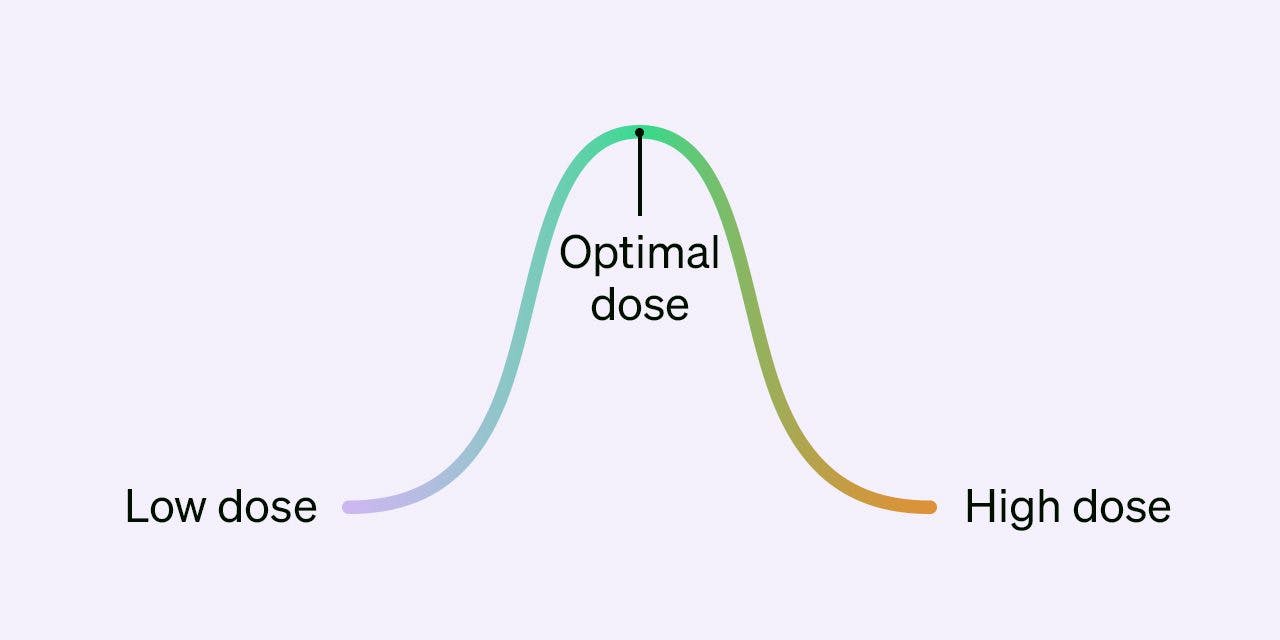The Biphasic Effects of Cannabis Explained

Article written by

Tina MagrabiSenior Content Writer
Content reviewed by

Dr. Lewis JasseyMedical Director - Pediatric Medicine
Have you ever noticed that one serving of an edible may make you feel calm and happy, but three servings may cause you to feel paranoid or anxious? If so, you’re experiencing the biphasic effects of cannabis.
Through the biphasic effects of cannabis, different concentrations of cannabinoids like CBD and THC result in varying physical and mental sensations. High doses of one cannabinoid may make a person feel alert, while lower doses of that same chemical may make a person feel relaxed (or vice-versa).
Learn more about the science behind the biphasic effects of cannabis and how to find the right dose to achieve your desired results.
Get your medical marijuana card
Connect with a licensed physician online in minutes.
What Does “Biphasic Effect” Mean?
Biphasic effect means a drug’s low and high doses cause opposite effects. Low doses of THC, for example, help some people to unwind. But high doses of THC could make those same people feel paranoid, even leading to hallucinations in extreme cases.
But biphasic effects are not limited to cannabis, and other drugs also cause opposite reactions at high and low concentrations. Alcohol, for example, may make you feel a pleasant “buzz” in small amounts, while large amounts could make you sad, as alcohol acts as a depressant.
All biphasic effects are rooted in how the brain, specifically the hippocampus, processes chemicals. Different doses of cannabis and other drugs interact uniquely with dopamine receptors, serotonin receptors, and other key neurotransmitters in the brain.
The Biphasic Effects of Cannabis
The biphasic effects of THC require greater care when compared with CBD and minor cannabinoids. This is because THC significantly impacts people’s emotions, perceptions, and physical reactions. Here are some science-backed examples of the potential biphasic effects of THC:
- Memory and cognition: Positive effect on memory and cognition in low doses, negative effect in high doses
- Anxiety: Decreases anxiety in low doses and increases anxiety in high doses
- Fertility: More fertility in low doses, less fertility in high doses
Many studies on THC’s biphasic effects involve animal rather than human subjects. More research and clinical trials are needed involving humans to understand the biphasic THC effects that people may experience.
CBD is also biphasic, although to a lesser degree than its psychoactive counterpart, THC. CBD generally has more stimulating effects in lower doses and sedative effects in higher doses. People diagnosed with anxiety or panic disorder may find these biphasic effects more pronounced with THC and CBD.
Another cannabinoid with distinct biphasic effects is tetrahydrocannabivarin (THCV). THCV is anti-psychoactive in low doses — meaning it can reduce some of THC’s psychoactivity — and is psychoactive in higher doses — meaning that it can synergize with THC and increase cannabis’ psychoactivity to some extent.
How to Find the Right Dose
Finding the right dose of cannabis can make the difference between feeling good and having a negative experience or “bad trip.” While there are no guarantees for how marijuana will make you feel (especially if you are new to the plant), there are ways to help avoid unwanted effects.
Here are some tips for creating the “cannabis cocktail” that is right for you:
Start Low, Go Slow
You can easily increase your cannabis dosage but can’t undo what you’ve already consumed. If you’re inexperienced with the psychoactive cannabinoid THC, start with the smallest amount possible. THC is often the culprit behind a negative cannabis experience, as too much of the cannabinoid could leave you feeling agitated, paranoid, or even panicked.
Start with 5 milligrams or less of THC to help prevent negative psychoactive effects. Also, consume your weed slowly over the course of a few hours rather than minutes. You may find after an hour of slow, low-dose consumption that you’ve reached your desired high and can stop there.
Choose the Right Ingestion Method
Some cannabis ingestion methods or routes of administration are more potent than others. Edibles have a reputation for having the strongest and longest-lasting effects on people. Consuming marijuana edibles in high doses has also sent countless people to the emergency room.
Rather than baking a batch of pot brownies, consider applying topical cannabis oil to your skin or placing a few drops of tincture under your tongue (sublingual). But if you choose to eat cannabis, follow the start low and go slow mantra, tipping your cannabinoid ratios more toward CBD than THC.
Use CBD Products
You can enjoy the potential therapeutic benefits of cannabis while consuming minimal amounts of THC. CBD products are widely available in health stores and other specialty shops. The item must contain no more than 0.3% THC to qualify as a CBD product. CBD products are also a good alternative if you live in a state that has not yet legalized medical marijuana.
The Bottom Line
With the right dose and CBD:THC ratio, you can help manage the biphasic effects of cannabis. Trial and error will likely come into play as you discover which dose and which consumption method works best for you.
In general, low doses of THC can help reduce anxiety and depression, and high doses of THC may prompt anxiety or a depressive episode. On the other hand, moderate to high doses of CBD may have sedative effects that can reduce anxiety, and lower doses of CBD may have more stimulating effects that may not manage anxiety or depression well.
If you have a specific medical condition you’re trying to treat with cannabis, speak with a healthcare provider that is well-versed in marijuana. If you don’t have one, Leafwell can match you with a medical marijuana doctor in your state.
Get Your Medical Card
Connect with a licensed physician online in minutes.
